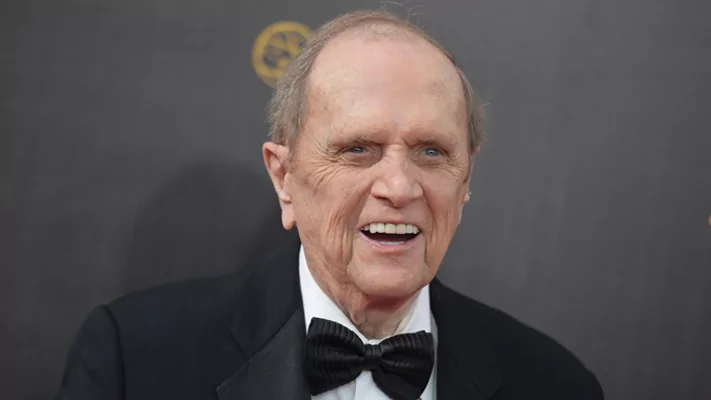Bob Newhart preferred his comedy to be neither shaken nor stirred but served dry — very, very dry.
The influential stand-up comedian, renowned sitcom star, and periodic motion picture player put forth a persona that was sharp, smart, and, above all, straight-laced.

Newhart, who died on July 18 at age 94, seemed earnestly perplexed by the universe in which he lived. He had the countenance of an accountant, which he had been at one point, and the demeanor of a psychologist, which he once played on TV. Even his faint stammer, which was authentic even as he marshaled it for comedic purposes, could be considered a condition of his bewilderment. Newhart proved that the flat could be funny.
Some comics work for years to develop their stage identities, but Newhart seemed to have been born with the rudiments of his persona. Those who listened to his comedy albums or watched his TV shows could scarcely have conceived a more appropriate biography than the real one: A son of the Midwest — he was one of four children born to George and Julia Newhart in Oak Park, Illinois — Newhart was not a rebel or subversive but an ordinary, if amused, participant in the midcentury American dream.
“From the outside in, it appeared a very normal upbringing,” Newhart said in a 2005 interview for the PBS series American Masters, adding that his family’s aspirations for attaining status in the upper-middle class were not quite attained. “Something happened between the time my father got his paycheck and the time he got home,” he said.
Humor was in the home. He said that he grew up reading H. Allen Smith and Robert Benchley. But upon receiving a degree in business management from Loyola University Chicago, and upon failing to receive a degree from Loyola University School of Law, Newhart toiled in accounting before attempting to make his funny bone pay.
Persuaded of his own comic instincts, Newhart and a business colleague named Ed Gallagher whipped up some amateur recordings. “I would get so bored at the end of the day with accounting that I could call Ed up, and we would improvise routines,” said Newhart, who called them “poor man Bob and Ray routines.”
Even so, in time, Newhart’s material reached radio airwaves and, eventually, nightclub audiences. Among his favorite gambits was to present himself on the receiving end of a telephone conversation: For example, in the routine “Abe Lincoln vs. Madison Avenue,” Newhart incarnates a press agent conversing with Abraham Lincoln.
“Listen, Abe, I got the note — what’s the problem? … You’re thinking of shaving it off? … Abe, don’t you see that’s part of the image?” the press agent says to the unheard 16th president. Later, the topic of a certain Union Army commander comes up: “Now, what’s this about Grant? … You’re getting a lot of complaints on Grant’s drinking, huh? … Abe, to be perfectly honest with you, I don’t see the problem. I mean, you knew he was a lush when you appointed him.”
Such routines became the raw material for a series of widely beloved comic albums, including his debut, The Button-Down Mind of Bob Newhart, which, in 1960, was not only a hit with record-buyers but won Grammys for album of the year and best new artist. This was succeeded by Behind the Button-Down Mind of Bob Newhart (1961), Bob Newhart Faces Bob Newhart (1964), and The Windmills Are Weakening (1965), among others.
Yet to take full measure of Newhart’s humor required more than just listening to him. The audience really needed to see his face: glum, bedraggled, maybe even slightly ornery were it not for his perpetual self-deprecation. Fleetingly, in 1961, Newhart was installed as the host of his own variety show, The Bob Newhart Show, and there were guest appearances in all the usual places: The Ed Sullivan Show, The Judy Garland Show, and so on. Finally, in 1972, CBS had the wisdom to give the comic his own sitcom, The Bob Newhart Show.
Playing a psychologist on the classic show, Newhart had found the perfect fictitious vantage point to observe the human parade, which, after all, had been the secret to his comedy all along. “There is this man, me, who keeps looking at the world and saying, ‘This is crazy,’” Newhart told American Masters.
Although The Bob Newhart Show concluded its run in 1978, the public still found its star a meekly humane source of identification, and, from 1982 to 1990, CBS aired a second sitcom, Newhart. This time, the star was a Vermont innkeeper inundated with misfits, though nothing could have been more idiosyncratic than the ending to the show itself: The last episode’s last scene makes it clear that the entire series had occurred in the dream state of the psychologist from The Bob Newhart Show.
CLICK HERE TO READ MORE FROM THE WASHINGTON EXAMINER
Newhart had his share of movie work, but his quiet, retiring demeanor was never a natural fit for the big screen. He had supporting roles in Hell is for Heroes (1962) and Hot Millions (1968), though his best movie part was surely as Major Major in Mike Nichols’s 1970 adaptation of Joseph Heller’s Catch-22. In the 21st century, he logged memorable appearances in Elf (2003) and on The Big Bang Theory or Young Sheldon.
It is unlikely that so ordinary a man will ever again have such an extraordinary show-business career.
Peter Tonguette is a contributing writer to the Washington Examiner magazine.























